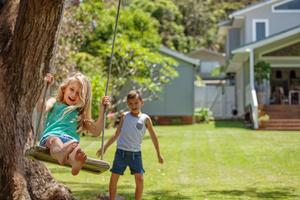By Michael Hawton, former teacher, psychologist (MAPS) and Parentshop founder.
In recent times, insurance companies have directly influenced educational systems to make them safer and less risky. Parents have also demanded that pre-schools and early years settings keep children safe 100% of the time. Certainly, since my children were at pre-school, raised cubby houses, tree houses and play equipment have been lowered or even removed to meet accrediting bodies’ demands.
I am not against safer routines per se and I am not against risk assessments being done; these checklists are good to do, and they help educators to consider things that they may not have thought about. But, I do think that we need to be aware of how a growing culture of ‘safetyism’ is translating into the way that we interact with children and the messages we inadvertently send to them about the world and their ability to cope with it.
One of my friends - now a grandmother – recently told me how she has observed her daughter-in-law often taking short, sharp ‘in-breaths’ in front of her four year old. This behaviour happens at the slightest whiff of danger or wrongdoing. It’s a habit, she reckons - and it’s making her grand-daughter increasingly anxious.
So, in both educational settings and in the smallest day-to-day interactions with young children, we appear to be becoming more focussed on risk.
There was a time not so long ago when, as educators and parents, we didn’t think like this. We didn’t see danger lurking around every corner and we didn’t fill our children with fear, based on the unlikely event of something possibly going wrong.
Take ‘stranger danger’ for example. Not only is this phrase a misnomer (because it’s more likely that a person harming a child will be a family member) but it fails children on two levels; it tells children that all strangers are potentially dangerous (which is patently absurd) and it does not give children the necessary practise they need to engage with a stranger to determine which strangers are safe and which ones they should be wary of. According to The Australian Institute of Criminology in their advisory report on missing children ‘Parents and educators must impress upon children the dangers of talking to strangers’. But, is this message exacerbating the highly-strung parent population?
It concerns me that a certain level of paranoia is creeping into our parenting and child-caring practices. And this can’t be good. When we see shadows where there are none or when evidence shows us that risks are minimal, we can distort risks posed to our kids. The perspective seems to be that if there is any risk at all, however small or remote, we must respond to mitigating that risk or find ourselves questioning how good a parent or educator we are.
In the US, which most of us would consider more dangerous than Australia or New Zealand, the chances that a stranger will kidnap or take a child are small. In fact, they are very small. Ninety-nine point eight percent of children who are reported missing, eventually return into their parents’ arms, unharmed - usually after not being where they are meant to be or because they ran away. In other words, the number of children who get taken by a stranger is minimal. For sure, we should be telling children not to go with someone they don’t know and we should tell them to never get into a car with someone they don’t know. But should we tell them to never talk to persons they don’t know?
Some years back, a New York mum by the name of Lenore Skenazy was portrayed as ‘the worst mum in America’. She became infamous for allowing her then nine-year old son to ride on the subway, alone, even though she had prepared him for this journey and trained him for it by travelling with him. She was lampooned as being irresponsible for daring to allow her child to travel by himself on the subway. But, Skenazy stated she was merely attempting to help her child engage in a limited-risk situation to improve his resilience skills.
In their new book on how parents have become overprotective, The Coddling of the American Mind, Haidt and Luckianoff (2018) say that the strengthening of children’s mental well-being may have something to do with how we facilitate a child’s experiences for life’s problem-solving episodes, including how they can be coached to engage with these problems independently. Haidt and Luckianoff say, “in many respects our lives are better as a result of huge advances in safety and technology. Our lives are more comfortable, which is good. But, that gives us problems of progress. We recoil violently from discomfort.”
Compared to the 1960s, the levels in our ability to resolve issues for ourselves, called our internal ‘locus of control’ has been steadily decreasing. A strong internal locus of control correlates with a belief we can control our own destiny. Without a healthy sense of internal locus of control, children can feel powerless and anxious. The long-term studies by Jean M. Twenge et al. (“It’s Beyond My Control: A Cross-Temporal, Meta-Analysis of Increasing Externality in Locus of Control, 1960 – 2002), have been reflecting this downturn in children’s capacity to manage problems independently.
So where does this leave us?
First, recognise that each time we jump in to protect a child from a risk – for the sake of being safe – we may be robbing them of an opportunity to develop resilience skills. Making a decision about whether to intervene or limit an activity is about assessing the problem and seeing if it can be an opportunity to help your child to learn new skills, to manage their fear, to increase resilience and become independent problem solvers. By allowing children to engage with small and even uncomfortable risks, we can teach them to trust their own judgment and develop coping strategies. We can also act as their guide to help them negotiate a challenging situation or resolve an issue for themselves, and thereby build their own sense of competency and efficacy.
If you haven’t yet seen it yet, the Forest schools movement in Denmark is a great example of when teachers don’t jump in and fix problems. They let kids climb trees and play with knives! Curious? Have a look here.
In addition, some parents believe it is their role to protect their child from experiencing any consequences that occur as a result of a child’s poor behaviour or poor choices.
This tendency to intervene (which some call ‘helicoptering’) is likely to undermine a child’s understanding of how the world works. It prevents a child from realising that his behaviour can have an impact on others and that some choices may result in uncomfortable outcomes. Through play and through social experimenting kids learn the first lessons of winning and losing. As well, children need to know that they can survive and cope with situations that are unpleasant or uncomfortable. Part of a parent’s role is helping children deal with adversity and not to step in to alleviate their discomfort.
Exposing our children to a small amount of risk gradually allows those children to learn to cope in the real world and to develop confidence and self-belief that they can cope, even when things don’t go according to plan. If Luckianoff and Haidt are correct, when they describe young adults as being the most over-protected generation to date, then we need to start educating our kids as early as possible to take risks and to learn to manage their uncomfortable feelings.
Michael Hawton is founder of Parentshop, providing education and resources for parents and industry professionals working with children.
Our latest course on guiding children’s behaviour Talk Less Listen More for early years educators, can be completed individually or as an early years’ staff group and will launch this month.
It meets the national quality standards and can be linked to here.


